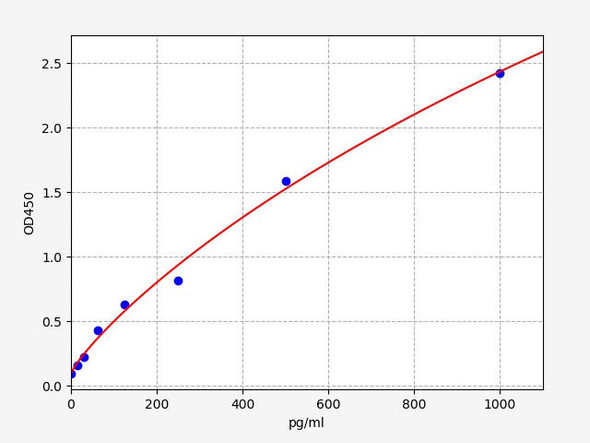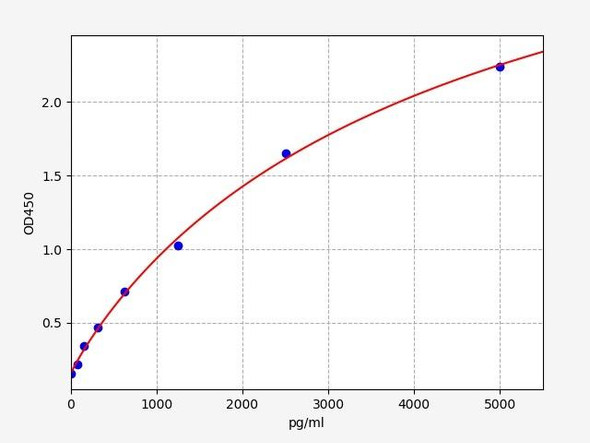Human Cell Biology ELISA Kits 2
Human NOS2/iNOS (Nitric Oxide Synthase 2, Inducible) ELISA Kit (HUES01897)
- SKU:
- HUES01897
- Product Type:
- ELISA Kit
- Size:
- 96 Assays
- Uniprot:
- P35228
- Sensitivity:
- 46.88pg/mL
- Range:
- 78.13-5000pg/mL
- ELISA Type:
- Sandwich
- Synonyms:
- NOS2A, HEP-NOS, I-NOS
- Reactivity:
- Human
- Sample Type:
- Serum, plasma and other biological fluids
- Research Area:
- Cell Biology
Description
| Assay type: | Sandwich |
| Format: | 96T |
| Assay time: | 4.5h |
| Reactivity: | Human |
| Detection Method: | Colormetric |
| Detection Range: | 78.13-5000 pg/mL |
| Sensitivity: | 46.88 pg/mL |
| Sample Volume Required Per Well: | 100µL |
| Sample Type: | Serum, plasma and other biological fluids |
| Specificity: | This kit recognizes Human NOS2/iNOS in samples. No significant cross-reactivity or interference between Human NOS2/iNOS and analogues was observed. |
This ELISA kit uses Sandwich-ELISA as the method. The micro ELISA plate provided in this kit has been pre-coated with an antibody specific to Human NOS2/iNOS. Standards or samples are added to the appropriate micro ELISA plate wells and combined with the specific antibody. Then a biotinylated detection antibody specific for Human NOS2/iNOS and Avidin-Horseradish Peroxidase (HRP) conjugate are added to each micro plate well successively and incubated. Free components are washed away. The substrate solution is added to each well. Only those wells that contain Human NOS2/iNOS, biotinylated detection antibody and Avidin-HRP conjugate will appear blue in color. The enzyme-substrate reaction is terminated by adding Stop Solution and the color turns yellow. The optical density (OD) is measured spectrophotometrically at a wavelength of 450 nm ± 2 nm. The OD value is proportional to the concentration of Human NOS2/iNOS. The concentration of Human NOS2/iNOS in samples can be calculated by comparing the OD of the samples to the standard curve.
| UniProt Protein Function: | Function: Produces nitric oxide (NO) which is a messenger molecule with diverse functions throughout the body. In macrophages, NO mediates tumoricidal and bactericidal actions. Also has nitrosylase activity and mediates cysteine S-nitrosylation of cytoplasmic target proteins such COX2. |
| UniProt Protein Details: | Catalytic activity: 2 L-arginine + 3 NADPH + 4 O2 = 2 L-citrulline + 2 nitric oxide + 3 NADP+ + 4 H2O. Cofactor: Heme group By similarity. Binds 1 FAD By similarity. Binds 1 FMN By similarity. Tetrahydrobiopterin (BH4). May stabilize the dimeric form of the enzyme By similarity. Enzyme regulation: Regulated by calcium/calmodulin. Aspirin inhibits expression and function of this enzyme and effects may be exerted at the level of translational/post-translational modification and directly on the catalytic activity By similarity. Subunit structure: Homodimer. Binds SLC9A3R1. Tissue specificity: Expressed in the liver, retina, bone cells and airway epithelial cells of the lung. Not expressed in the platelets. Induction: By endotoxins and cytokines. Induced by IFNG/IFN-gamma acting synergistically with bacterial lipopolysaccharides (LPS), TNF or IL1B/interleukin-1 beta. Ref. 14 Polymorphism: Note=Genetic variations in NOS2 are involved in resistance to malaria [ MIM:611162]. Sequence similarities: Belongs to the NOS family. Contains 1 FAD-binding FR-type domain. Contains 1 flavodoxin-like domain. |
| NCBI Summary: | Nitric oxide is a reactive free radical which acts as a biologic mediator in several processes, including neurotransmission and antimicrobial and antitumoral activities. This gene encodes a nitric oxide synthase which is expressed in liver and is inducible by a combination of lipopolysaccharide and certain cytokines. Three related pseudogenes are located within the Smith-Magenis syndrome region on chromosome 17. [provided by RefSeq, Jul 2008] |
| UniProt Code: | P35228 |
| NCBI GenInfo Identifier: | 1352513 |
| NCBI Gene ID: | 4843 |
| NCBI Accession: | P35228. 2 |
| UniProt Secondary Accession: | P35228,O60757, O94994, Q16263, Q16692, Q4TTS5, Q9UD42 A1L3U5, B7ZLY2, |
| UniProt Related Accession: | P35228 |
| Molecular Weight: | 131,117 Da |
| NCBI Full Name: | Nitric oxide synthase, inducible |
| NCBI Synonym Full Names: | nitric oxide synthase 2, inducible |
| NCBI Official Symbol: | NOS2 |
| NCBI Official Synonym Symbols: | NOS; INOS; NOS2A; HEP-NOS |
| NCBI Protein Information: | nitric oxide synthase, inducible; NOS type II; NOS, type II; inducible NOS; hepatocyte NOS; inducible NO synthase; nitric oxide synthase, macrophage; peptidyl-cysteine S-nitrosylase NOS2; nitric oxide synthase 2A (inducible, hepatocytes) |
| UniProt Protein Name: | Nitric oxide synthase, inducible |
| UniProt Synonym Protein Names: | Hepatocyte NOS; HEP-NOS; Inducible NO synthase; Inducible NOS; iNOS; NOS type II; Peptidyl-cysteine S-nitrosylase NOS2 |
| Protein Family: | Inositol 3-kinase |
| UniProt Gene Name: | NOS2 |
| UniProt Entry Name: | NOS2_HUMAN |
As the OD values of the standard curve may vary according to the conditions of the actual assay performance (e. g. operator, pipetting technique, washing technique or temperature effects), the operator should establish a standard curve for each test. Typical standard curve and data is provided below for reference only.
| Concentration (pg/mL) | O.D | Average | Corrected |
| 5000 | 2.523 2.535 | 2.529 | 2.459 |
| 2500 | 1.766 1.774 | 1.77 | 1.7 |
| 1250 | 1.02 0.984 | 1.002 | 0.932 |
| 625 | 0.514 0.524 | 0.519 | 0.449 |
| 312.5 | 0.304 0.296 | 0.3 | 0.23 |
| 156.25 | 0.192 0.168 | 0.18 | 0.11 |
| 78.13 | 0.121 0.131 | 0.126 | 0.056 |
| 0 | 0.065 0.075 | 0.07 | -- |
Precision
Intra-assay Precision (Precision within an assay): 3 samples with low, mid range and high level Human NOS2/iNOS were tested 20 times on one plate, respectively.
Inter-assay Precision (Precision between assays): 3 samples with low, mid range and high level Human NOS2/iNOS were tested on 3 different plates, 20 replicates in each plate.
| Intra-assay Precision | Inter-assay Precision | |||||
| Sample | 1 | 2 | 3 | 1 | 2 | 3 |
| n | 20 | 20 | 20 | 20 | 20 | 20 |
| Mean (pg/mL) | 276.20 | 441.40 | 2054.00 | 265.80 | 481.50 | 2256.90 |
| Standard deviation | 14.10 | 24.70 | 71.90 | 17.30 | 26.50 | 92.50 |
| C V (%) | 5.10 | 5.60 | 3.50 | 6.51 | 5.50 | 4.10 |
Recovery
The recovery of Human NOS2/iNOS spiked at three different levels in samples throughout the range of the assay was evaluated in various matrices.
| Sample Type | Range (%) | Average Recovery (%) |
| Serum (n=5) | 95-108 | 101 |
| EDTA plasma (n=5) | 94-107 | 99 |
| Cell culture media (n=5) | 85-95 | 90 |
Linearity
Samples were spiked with high concentrations of Human NOS2/iNOS and diluted with Reference Standard & Sample Diluent to produce samples with values within the range of the assay.
| Serum (n=5) | EDTA plasma (n=5) | Cell culture media (n=5) | ||
| 1:2 | Range (%) | 93-106 | 96-112 | 89-103 |
| Average (%) | 100 | 103 | 95 | |
| 1:4 | Range (%) | 101-118 | 82-94 | 94-105 |
| Average (%) | 108 | 89 | 100 | |
| 1:8 | Range (%) | 100-115 | 82-94 | 97-112 |
| Average (%) | 106 | 87 | 102 | |
| 1:16 | Range (%) | 97-107 | 79-91 | 93-106 |
| Average (%) | 102 | 86 | 99 |
An unopened kit can be stored at 4°C for 1 month. If the kit is not used within 1 month, store the items separately according to the following conditions once the kit is received.
| Item | Specifications | Storage |
| Micro ELISA Plate(Dismountable) | 8 wells ×12 strips | -20°C, 6 months |
| Reference Standard | 2 vials | |
| Concentrated Biotinylated Detection Ab (100×) | 1 vial, 120 µL | |
| Concentrated HRP Conjugate (100×) | 1 vial, 120 µL | -20°C(shading light), 6 months |
| Reference Standard & Sample Diluent | 1 vial, 20 mL | 4°C, 6 months |
| Biotinylated Detection Ab Diluent | 1 vial, 14 mL | |
| HRP Conjugate Diluent | 1 vial, 14 mL | |
| Concentrated Wash Buffer (25×) | 1 vial, 30 mL | |
| Substrate Reagent | 1 vial, 10 mL | 4°C(shading light) |
| Stop Solution | 1 vial, 10 mL | 4°C |
| Plate Sealer | 5 pieces | |
| Product Description | 1 copy | |
| Certificate of Analysis | 1 copy |
- Set standard, test sample and control (zero) wells on the pre-coated plate and record theirpositions. It is recommended to measure each standard and sample in duplicate. Note: addall solutions to the bottom of the plate wells while avoiding contact with the well walls. Ensuresolutions do not foam when adding to the wells.
- Aliquot 100 µL of standard solutions into the standard wells.
- Add 100 µL of Sample / Standard dilution buffer into the control (zero) well.
- Add 100 µL of properly diluted sample (serum, plasma, tissue homogenates and otherbiological fluids) into test sample wells.
- Cover the plate with the sealer provided in the kit and incubate for 90 min at 37 °C.
- Aspirate the liquid from each well, do not wash. Immediately add 100 µL of BiotinylatedDetection Ab working solution to each well. Cover the plate with a plate seal and gently mix. Incubate for 1 hour at 37 °C.
- Aspirate or decant the solution from the plate and add 350 µL of wash buffer to each welland incubate for 1-2 minutes at room temperature. Aspirate the solution from each well andclap the plate on absorbent filter paper to dry. Repeat this process 3 times. Note: a microplatewasher can be used in this step and other wash steps.
- Add 100 µL of HRP Conjugate working solution to each well. Cover with a plate seal andincubate for 30 min at 37 °C.
- Aspirate or decant the solution from each well. Repeat the wash process for five times asconducted in step 7.
- Add 90 µL of Substrate Reagent to each well. Cover with a new plate seal and incubate forapproximately 15 min at 37 °C. Protect the plate from light. Note: the reaction time can beshortened or extended according to the actual color change, but not by more than 30min.
- Add 50 µL of Stop Solution to each well. Note: Adding the stop solution should be done inthe same order as the substrate solution.
- Determine the optical density (OD value) of each well immediately with a microplate readerset at 450 nm.






